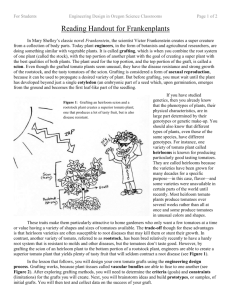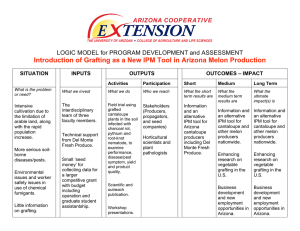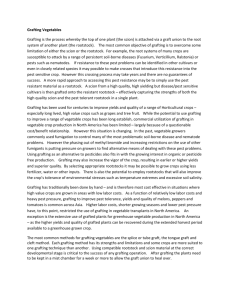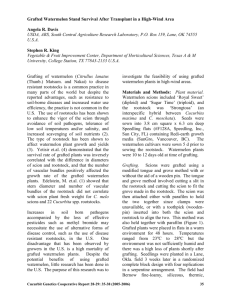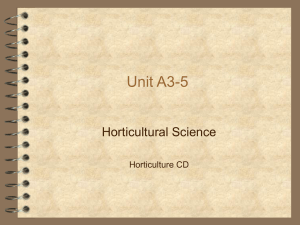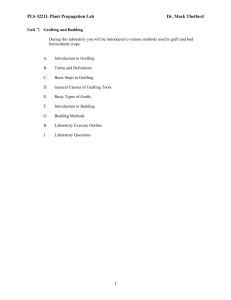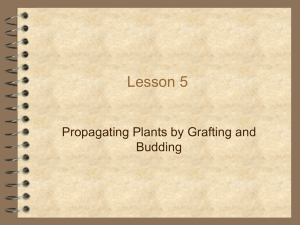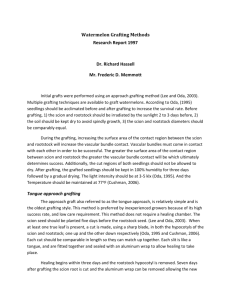Grafting for Disease Resistance
advertisement
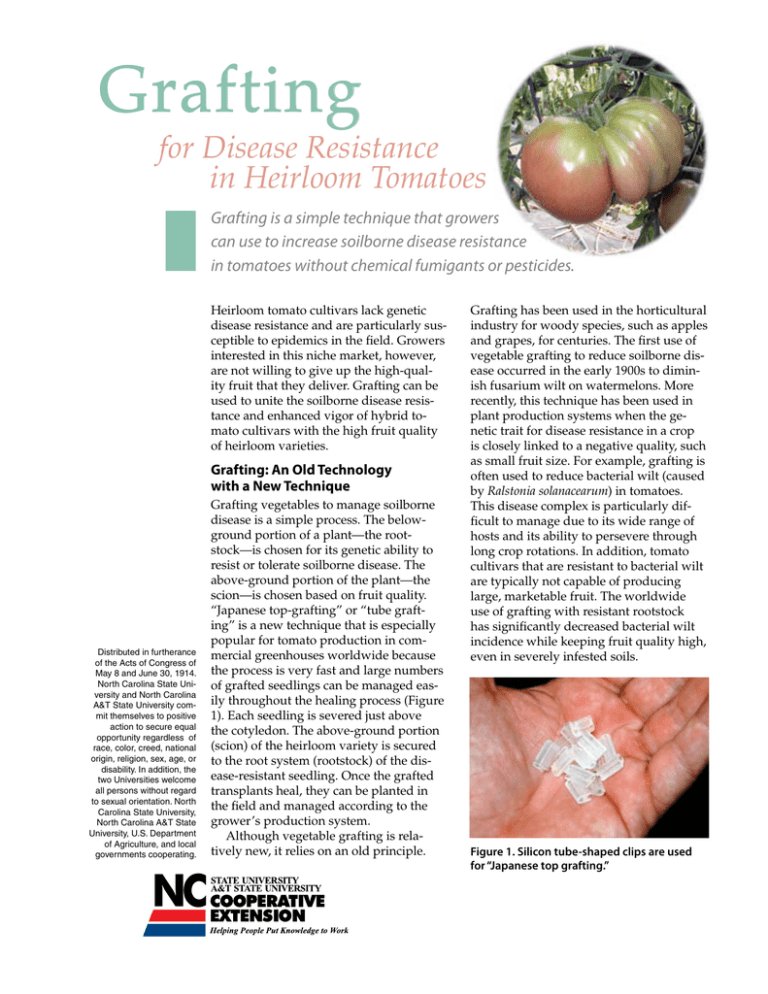
Grafting for Disease Resistance in Heirloom Tomatoes Grafting is a simple technique that growers can use to increase soilborne disease resistance in tomatoes without chemical fumigants or pesticides. Heirloom tomato cultivars lack genetic disease resistance and are particularly susceptible to epidemics in the field. Growers interested in this niche market, however, are not willing to give up the high-quality fruit that they deliver. Grafting can be used to unite the soilborne disease resistance and enhanced vigor of hybrid tomato cultivars with the high fruit quality of heirloom varieties. Grafting: An Old Technology with a New Technique Distributed in furtherance of the Acts of Congress of May 8 and June 30, 1914. North Carolina State University and North Carolina A&T State University commit themselves to positive action to secure equal opportunity regardless of race, color, creed, national origin, religion, sex, age, or disability. In addition, the two Universities welcome all persons without regard to sexual orientation. North Carolina State University, North Carolina A&T State University, U.S. Department of Agriculture, and local governments cooperating. Grafting vegetables to manage soilborne disease is a simple process. The belowground portion of a plant—the rootstock—is chosen for its genetic ability to resist or tolerate soilborne disease. The above-ground portion of the plant—the scion—is chosen based on fruit quality. “Japanese top-grafting” or “tube grafting” is a new technique that is especially popular for tomato production in commercial greenhouses worldwide because the process is very fast and large numbers of grafted seedlings can be managed easily throughout the healing process (Figure 1). Each seedling is severed just above the cotyledon. The above-ground portion (scion) of the heirloom variety is secured to the root system (rootstock) of the disease-resistant seedling. Once the grafted transplants heal, they can be planted in the field and managed according to the grower’s production system. Although vegetable grafting is relatively new, it relies on an old principle. Grafting has been used in the horticultural industry for woody species, such as apples and grapes, for centuries. The first use of vegetable grafting to reduce soilborne disease occurred in the early 1900s to diminish fusarium wilt on watermelons. More recently, this technique has been used in plant production systems when the genetic trait for disease resistance in a crop is closely linked to a negative quality, such as small fruit size. For example, grafting is often used to reduce bacterial wilt (caused by Ralstonia solanacearum) in tomatoes. This disease complex is particularly difficult to manage due to its wide range of hosts and its ability to persevere through long crop rotations. In addition, tomato cultivars that are resistant to bacterial wilt are typically not capable of producing large, marketable fruit. The worldwide use of grafting with resistant rootstock has significantly decreased bacterial wilt incidence while keeping fruit quality high, even in severely infested soils. Figure 1. Silicon tube-shaped clips are used for “Japanese top grafting.” Benefits Grafting can be used where growers need to increase soilborne disease resistance and keep fruit quality high to compete in fresh-produce markets. Grafted tomato transplants are able to combine the high-quality fruit of heirloom cultivars with the disease resistance, stress tolerance, and vigor of modern rootstock cultivars. (For further details on how grafting has been used to increase crop production worldwide, see “Recommended Reading” at the end of this publication.) Disease resistance Researchers around the world have demonstrated that grafting can be effective against a variety of soilborne fungal, bacterial, viral, and nematode diseases. It has been used to eliminate verticillium and fusarium wilt in tomato and cucurbit production systems in Japan, Korea, and Greece. In New Zealand, it has been used to reduce levels of corky root rot. In Morocco and Greece, grafting is used to control root-knot nematodes (Meloidogyne species) in both tomatoes and cucurbits. Researchers have proposed using grafted plants instead of methyl bromide to manage soilborne disease in these regions of the world. Grafting has been essential in Asian horticultural production for eliminating bacterial wilt incidence in solanaceous crops, such as tomatoes and peppers. It has also been used in tropical environments, like the Southeast Asian kingdom of Brunei, where bacterial wilt incidence is so high that tomatoes cannot be planted unless the soil is sterilized or resistant rootstocks are used. In India, wilt-resistant rootstocks were used in one experiment to reduce bacterial wilt in tomatoes. By the end of the season, none of the control plants had survived while 100 percent of the grafted plants continued to produce. Furthermore, the yield of the tomatoes with re- sistant rootstocks was four times that of the nongrafted susceptible plants. Grafting can be a valuable tool for eliminating bacterial wilt in tomato, pepper, and eggplant production. Stress tolerance Grafting has been highly effective at producing plants that can overcome abiotic stressors—the environmental stressors that can lead to decreased yields. More than one-third of all irrigated land worldwide is affected by high salinity. Grafting with salt-tolerant rootstocks can be instrumental in decreasing yield losses. It has also been used to reduce the negative effects of excess moisture in the soil. Grafted plants also have shown effective tolerance to soil temperature extremes, and grafting with certain rootstocks can allow the growing season to be extended in either direction. An extended season can help growers to raise the selling price of their goods as well as add to annual and long-term economic stability. Increased productivity The use of grafted vegetables is associated with increased resistance to diseases, abiotic stressors, or both. But grafting can also increase yields without the presence of these stressors. For example, yields increased by as much as 106 percent with the use of certain rootstocks for watermelon production in Australia. Some rootstock varieties have been bred specifically to be used as rootstocks, such as the Maxifort rootstock used in greenhouse tomato production systems. Use of vigorous rootstock varieties can increase water and nutrient uptake in grafted plants. Many growers worldwide are utilizing these rootstocks to increase fruit yields, even where little disease pressure is evident. Table 1. Disease resistance and vigor of commercial tomato rootstock cultivars. (Ratings are based on seed supplier information. Vigor is measured on a scale of 1 to 5, where 1 represents poor and 5 represents excellent.) Disease Resistance Verticillium Fusarium Wilt Wilt Race 1 Race 2 Race 1 Tomato Mosaic Virus Corky Root Maxifort High High Moderate High Beaufort High High Moderate Anchor-T High Susceptible Survivor High Aegis Seed Supplier/ Rootstock deRuiter Seeds Bacterial Wilt Nematodes Vigor High Susceptible High 5 High High Susceptible High 3 High High High Moderate High 5 Susceptible High High High Moderate High 5 High Moderate High High High Moderate High 4 Body High High Susceptible High High Susceptible High 5 Robusta High High Susceptible High High Susceptible Susceptible 3 Takii Seeds Bruinsma Seeds Table 2. Traditional and 2005 international resistance codes for tomato cultivars Common Name Tomato mosaic Tomato spotted wilt virus Spotted wilt TSWV TSWV Ralstonia solanacearum Bacterial wilt R Rs Fusarium oxysporum f. sp. lycopersici Fusarium wilt (Races 0 & 1) FF or F2 Fol: 0, 1 Fusarium oxysporum f. sp. radicis-lycopersici Fusarium crown and root rot Fr For Pyrenochaeta lycosersici Corky root rot K Pt Verticillium albo-atrum Verticillium wilt V Va Verticillium dahliae Verticillium wilt V Vd Meloidogyne spp. Root-knot nematodes N Mj, Mi, Ma Grafting Step-by-Step Although grafting is a simple process, it requires careful attention to rootstock selection, seeding dates, healing, and planting in the field. To produce healthy transplants from grafting, follow these steps. Choose the scion and rootstock cultivars Any cultivar that provides the desired fruit characteristics can be used to produce scions for grafting. For heirloom tomato growers, popular scion choices include German Johnson, Cherokee Purple, and Kellogg’s Breakfast. Select the rootstock based on its potential for resisting the soilborne diseases on your farm and its ability to enhance marketable yield, even in the absence of disease pressure. Rootstock selection is probably the single most important step in grafting heirloom tomatoes for disease resistance. To choose the right rootstock, identify the potential pathogens on your farm. Fields where solanaceous crops (tomatoes, tobacco, potatoes, and peppers) have been grown often have recurring problems with bacterial wilt. This disease is widespread in Eastern North Carolina, and many farmers have abandoned fields due to total crop failures from bacterial wilt. In the Appalachian growing regions, verticillium wilt causes severe damage to tomato crops because the climate favors the development of this pathogen in the soil. Root-knot nematodes can be diagnosed through soil sampling prior to planting, but occur most frequently in sandy soils. Your county Extension agent can help you learn about basic diagnosis so you can identify potential pathogens in your fields that can hinder productivity. Many Asian and European companies are releasing varieties that have been bred for rootstock use. Sakata Seed Company and Takii Seeds (Japan) and Bruinsma Seeds and deRuiter Seeds (the Netherlands) have developed lines specifically for rootstock use, but their distribution in the United States may be limited. Table 1 lists some rootstock varieties that are available in the U.S. and their levels of disease resistance. Although the ideal solution is to find varieties bred Traditional Code Tm 2005 International Code ToMV Scientific Name Tomato mosaic virus specifically for rootstock production, typical hybrids or other modern varieties may also be valuable as disease resistant rootstocks for heirloom cultivars. The key to choosing the right rootstock is to understand how to “break the tomato code.” As breeders have developed genetic lines with resistance, they have designated international resistance codes (Table 2) that can be displayed on labels to identify a cultivar’s resistance to specific diseases. For example, a “Roma VdFol:1” variety is one that has been shown to resist race 1 of Verticillium dahliae (Vd) and race 1 of Fusarium oxysporum f. sp. lycopersici (Fol:1), which are soilborne pathogenic fungi. Many modern hybrids have been bred to resist several pathogens. By using the resistance available in modern tomato breeds, growers may be able to grow some of the tastiest heirloom varieties, even in severely infested fields. Construct a healing chamber After the rootstock and scion are grafted together, the resulting plants must reconnect vascular tissue so that water and nutrients can be supplied to the scion. This process occurs in a chamber where humidity, light, and temperature can be regulated. Although construction is relatively simple and inexpensive, proper placement on a farm can be somewhat difficult. While the grafts are healing in the chamber, they must receive 80 to 95 percent humidity, minimal direct sunlight, and a temperature range between 70 and 80oF. Daily temperature variation must remain low, as additional stress can decrease grafting success. The best place for a healing chamber would be indoors, in a heated storage area or garage, where fluorescent lights can be used during the final days of healing. Healing chambers can also be maintained inside a greenhouse during the spring and fall so long as sufficient shading devices are set up to keep the grafts from being exposed to excessive heat inside the chamber. A simple healing chamber consists of a frame covered by polyethylene sheeting, which keeps the humidity level high during the healing process. The floor of the Figure 2. A healing chamber for tomato grafts. Once grafts are placed in the chamber, black plastic is used to keep out all available sunlight. chamber should hold water. During the first days after grafting, an opaque covering is used to keep all light out of the chamber. At N.C. State University, a number of chambers have been built for tomato grafting. One of the most successful chambers is the simplest and least expensive: 1. Stretch a tarp or dense shade cloth above the greenhouse bench to reduce the full sunlight in the area where the healing chamber will reside. Be sure that the shaded area is much larger than the chamber in order to provide reduced light levels throughout the day and reduce the risk of excessive heat from building up inside the chamber. 2. Place a layer of plastic sheeting on the surface of the bench so that the raised edges of the bench can provide a shallow pool of water on the chamber floor. If a raised lip is not available to help hold water in the chamber, shallow pans of water can be distributed on the bench among the grafts. The use of cool-water vaporizers is an excellent way to increase the humidity within the chamber as long as it does not increase the internal temperature of the chamber. 3. Construct a frame using 1-inch polyvinyl chloride (PVC) piping as illustrated in Figure 2. The frame should have a peak to keep condensation from dripping onto the newly grafted transplants. 4. Cover the PVC frame with a layer of clear plastic so that the sides and ends can be easily pulled up to check on the grafts during healing. 5. Make sure humidity, light, and temperature levels inside the chamber are constant before beginning the grafting procedure so that the grafts will be placed into a well-functioning chamber. As noted above, the relative humidity level should be high—between 80 and 95 percent, and the temperature should be a constant 70 to 80oF. Use black plastic to block all available sunlight from entering the chamber until the leaves of the newly grafted transplants attain normal turgor levels—until they no longer show signs of moisture stress. Plant the seeds When planting the scion and rootstock seeds, use good sanitation practices and a sterile, lightweight potting mix. The grafting process and the subsequent healing time require that seeds be sown two weeks before typical, nongrafted transplant production begins. This allows the newly grafted seedlings to spend up to one week in the chamber followed by one week in the greenhouse to re-acclimate to normal light conditions before they are put into the field. To achieve a successful graft, make sure that the rootstock and the scion stems are the same diameter. Because different varieties require different germination periods, seeding times may need to be altered to grow different cultivars to the same size. Stagger plantings to offset the effects of variable germination periods between rootstock and scion varieties. In many cases, rootstock varieties take two to five days longer to germinate than heirlooms. However, hybrid rootstock varieties may germinate faster than heirlooms. Plant a few test seeds of each variety (both rootstock and scion) early in the year to determine how long the germination period is for each in your greenhouse or propagation facility. If seedlings have already emerged and either the rootstock or scion is much larger than its corresponding variety, decreasing the environmental temperature can help to slow the growth of the variety that may be ahead of schedule. Choose the best time to graft Tube grafting should be carried out when the seedlings have two to four true leaves and the stems are 1.5 to 2 millimeters in diameter (Figure 3). For proper healing to take place, the vascular tissue in the rootstock and scion must align so that their tissues can easily grow together, forming a strong union for water and nutrient uptake. Again, an essential component for grafting success is to use rootstock and scion plants that have similar stem diameters. Grafting should take place when there is little water stress upon the plants. Early in the morning or just after Figure 3. Seedlings are grafted dark are excellent times when two to four leaves are to graft as transpiration present. has typically slowed to reduced levels. Additionally, the grafting process should be carried out indoors or under some sort of shading device. If daytime grafting is essential due to timing and labor concerns, move the plants to a shady area in the morning before transpiration increases to prevent unwanted water stress during the process. degree of each angular cut does not have to be exact, all cuts should be made at a consistent angle to provide more surface area for the vascular tissue to meet and grow together. Other methods have attempted to increase this surface area even further by making Vshaped cuts, but the results are similar to those of the tube grafting technique. Locate the graft union above the cotyledon to prevent adventitious roots from forming and leading to infection of the susceptible scion tissue (Figure 5). Once the transplants have been grafted, put them directly into the healing chamber and cover the chamber to prevent any light from reaching the plants. Monitor the healing process Immediately after grafting takes place, the plants must form callus tissue and reconnect vascular bundles to provide the scion with nutrients and water. The purpose of the healing Figure 5. Adventitious roots Make the grafts chamber is to keep the from the scion could lead to Sanitation is extremely important during grafting. scion from becoming infection. Wash with anti-microbial soap, and use latex gloves water stressed during and sterile tools to reduce the exposure of the plant to this process. This can be accomplished by slowing the pathogenic bacteria, fungi, and viruses. transpiration stream—the movement of water from inTo make a graft, sever the bottom half of a rootstock side the plant tissue into the atmosphere. The best ways seedling from its top at a 45-degree angle, and sever to do this are to increase humidity, decrease light, and the top half of a scion seedling from its bottom at a 45decrease temperature. By decreasing the temperature, degree angle. Attach the rootstock to the scion with a however, the development of newly forming callus tisrubber or silicon clip (Figure 4). Although the specific sue may be hindered. Therefore, the keys to successful chamber operation are high humidity and no direct sunlight while the graft union is developing—between two and four days after making the graft. The first major constraint to proper graft healing is water stress. Because the scions have been physically separated from their root systems, they tend to wilt, especially in the first few hours after grafting. By adjusting environmental conditions to keep the Figure 4. Rootstock and scion stems are severed at a 45-degree angle and united with a scions from wilting sesilicon clip. ~ 5 weeks Humidity 95%RH RH 85-95% Dark Full Sunlight Partial 7-10 days FullFull Sunlight Sunlight 7 days 7 days Tr a mo nspl ve ant dt sa of iel re d. G pl raf an ts ts ar e he are m al mo ade in g ved , an ch am i n t d Gr be o af r. t e m d ov tra ed ns in pla to fu nts ll l ar ig e ht . sc Bot ion h em root e st 2-d rge ock ay wit and wi hin nd a ow . Sc io n Ro ot st o pl ck an se te ed se d. ed is is pl an te d. 2 to 5 days Figure 6. A typical timeline for grafting. (Rivard and Louws) verely, the grafts will have a better chance of survival. Typically, a small amount of wilt during the first day of healing is acceptable. The high humidity level inside the healing chamber will help the scions regain sufficient turgor pressure and show little sign of wilting. Grafts should be left in the chamber for the first two to four days with absolutely no light and high humidity. After these first days, the successful grafts will become apparent as they will regain normal turgor levels while those that were not successful will wilt permanently. Any movement that pulls the scion stem away from the rootstock will decrease the contact surface between these tissues, ultimately diminishing graft success. Place the grafts into the chamber carefully. Inspect the grafts after placing them in the chamber to be sure that the scion has not been pulled away from the rootstock. Excess water on the leaves can also physically pull the scion away from the rootstock. For this reason, do not mist grafts once they are in the chamber. While the grafts are still weak and healing, apply water from the bottom so that the grafts are not subjected to damage from overhead irrigation. should return to normal turgor levels and display no evidence of moisture stress. Once the grafts reach normal turgor levels, light can be slowly introduced, and eventually humidity levels can be reduced over the following week. There is a danger that this process can be carried out too fast. When light is first introduced back into the chamber, it is best to simulate indirect light. If the chamber is indoors, mount fluorescent lights above the chamber. In the greenhouse, use a shading apparatus that will significantly reduce the amount of sunlight without eliminating it altogether. As soon as the transplants have Acclimate the grafts to normal conditions Throughout the healing process, open the chamber at least twice a day to replenish carbon dioxide for the grafts. After two to four days in the healing chamber with absolutely no light and high humidity, the scions Figure 7. The clip falls after healing. acclimated to the reduced light level with no signs of stress, gradually decrease humidity by removing pans of water or the cool-water vaporizer and lifting up the sides of the chamber. Typically, the grafts will require two days at medium light and humidity levels before they can be moved into a low-humidity and high-light environment. Even after the plants have been moved out of the chamber and into a standard greenhouse environment, it is best to water from the bottom to prevent any physical damage to the grafts while the graft union is still weak. Careful overhead watering is possible as long as the seedlings are not exposed to high water pressure that could separate a scion from its rootstock. As the grafted transplants develop, the grafting clip will expand with the growing stem, and eventually fall off (Figure 7). Once the grafted transplants have been in the greenhouse for five to seven days, they can be managed and planted in the field or greenhouse similarly to nongrafted transplants. Avoid the pitfalls Although grafting with resistant rootstock increases the disease resistance of plants in the field, the process may expose transplants to diseases, edema, and disfigurement, all of which could weaken them. The wound created by cutting the stem provides an easy entry point for bacteria, fungi, and viruses to This is not a serious problem. Move the transplants into an environment with lower relative humidity, and the edema should go away. If the graft union did not maintain good contact, it may become disfigured. This may cause problems in the field if the union is not strong enough to hold the weight of the vines. Avoid this problem by taking precautions during grafting, planting, and training. Figure 9. Transplant so the graft union is well above the soil line. Plant and monitor the transplants Plant the transplants so that the graft union is well above the soil line (Figure 9). Many tomato growers hope to give transplants an advantage by burying transplants deep into the ground with the stem bent. This practice is not recommended with grafted transplants as susceptible scion tissue may be exposed to soilborne pathogens below ground. Monitor the grafted tomatoes once they are in the field to keep suckers from robbing the scion of water and nutrients. Suckers are branches that form below the graft union. Often they have a much different morphology than that of the scion. Fruit from the rootstockborne sucker branches will have the genetic makeup of the rootstock rather than the scion. By removing these branches, the scion will be provided with more water and nutrients and increase production of the desired high-quality fruit. Summary Figure 8. Edema on leaves. invade the plant tissue. Therefore, keep the working area, chamber, and all tools extremely clean during this process. Use good sanitation practices to prevent soil contamination, and use lightweight potting mixes that reduce the moisture retention in the soil for proper grafted transplant production. Edema, which appears as swollen areas of plant tissue, may form on the leaves if the grafts are allowed to stay in the chamber too long (Figure 8). Edema is a physiological disorder caused by excessive humidity. Grafting is a valuable disease management tactic for heirloom tomato growers. This practice originated as a way to ensure fruit quality while keeping disease resistance high for melon production systems with soilborne disease pressure. This same principle lends itself well to heirloom tomato production. Furthermore, research worldwide has demonstrated increased yields from grafted vegetable plants in comparison to nongrafted plants. As Southeastern growers realize its potential benefits and relative ease, grafting will become a more popular disease management technique in the United States. Recommended Reading Abdelhaq, H. 2004. Integrated production and protection in greenhouse crops. Extension Publication. Institut Agronomique et Vétérinaire Hassan II. Morocco. Black, L. 2003. Grafting tomatoes for production in the hot-wet season. International Cooperators’ Guide. Asian Vegetable Research & Development Center. Pub. no. 03-551, May. Republic of China: Taiwan. Bradley, J. 1968. Tomato grafting to control root diseases. New Zealand Journal of Agriculture. 116:26-27. Giannakou, I., and D. Karpouzas. 2003. Evaluation of chemical and integrated strategies as alternatives to methyl bromide for the control of root-knot nematodes in Greece. Pest Management Science. 59:883-892. Grimault, V., and P. Prior. 1994. Grafting tomato cultivars resistant of and susceptible to bacterial wilt–Analysis of resistance mechanisms. Journal of Phytopathology-Phytopathologische Zeitschrift. 141:330-334. Ioannou, N. 2001. Integrating soil solarization with grafting on resistant rootstocks for management of soilborne pathogens of eggplant. Journal of Horticultural Science & Biotechnology. 76:396-401. Lee, M. 1994. Cultivation of grafted vegetables. I. Current status, grafting methods, and benefits. HortScience. 29:235-239. Oda, M. 1995. New grafting method for fruit-bearing vegetables in Japan. Japan Agricultural Research Quarterly. 29: 187-194. Oda, M. 1999. Grafting of vegetables to improve greenhouse production. Extension Bulletin (December). College of Agriculture, Osaka Prefecture University. Japan: Osaka. Peregrine, W. 1982. Grafting - A simple technique for overcoming bacterial wilt in tomato. Tropical Pest Management. 28:71-76 Rivero, R. 2003. Role of grafting in horticultural plants under stress conditions. Food, Agriculture & Environment. 1:70-74. Tikoo, S. 1979. Successful graft culture of tomato in bacterial wilt sick soils. Current Science. 48:259-260. Yetisir, H., and N. Sari. 2003. Effect of different rootstock on plant growth, yield, and quality of watermelon. Australian Journal of Experimental Agriculture. 43:1269-1274. Acknowledgements The authors wish to thank Dr. Mary Peet, Dr. Mike Benson, Jim Driver, Bob Stuart, and the N.C. State University Department of Plant Pathology for their assistance with this publication. Cary Rivard provided the cover photograph of a Cherokee Purple heirloom tomato and all other photographs except Figure 8 (by Mary Peet). Prepared by Cary Rivard, Graduate Research Assistant Frank Louws, Ph.D., Associate Professor Department of Plant Pathology 1,000 copies of this public document were printed at a cost of $1,224, or $1.22 per copy. Published by NORTH CAROLINA COOPERATIVE EXTENSION SERVICE NC STATE UNIVERSITY AG-675 E07 45829 9/06—1M—BS
